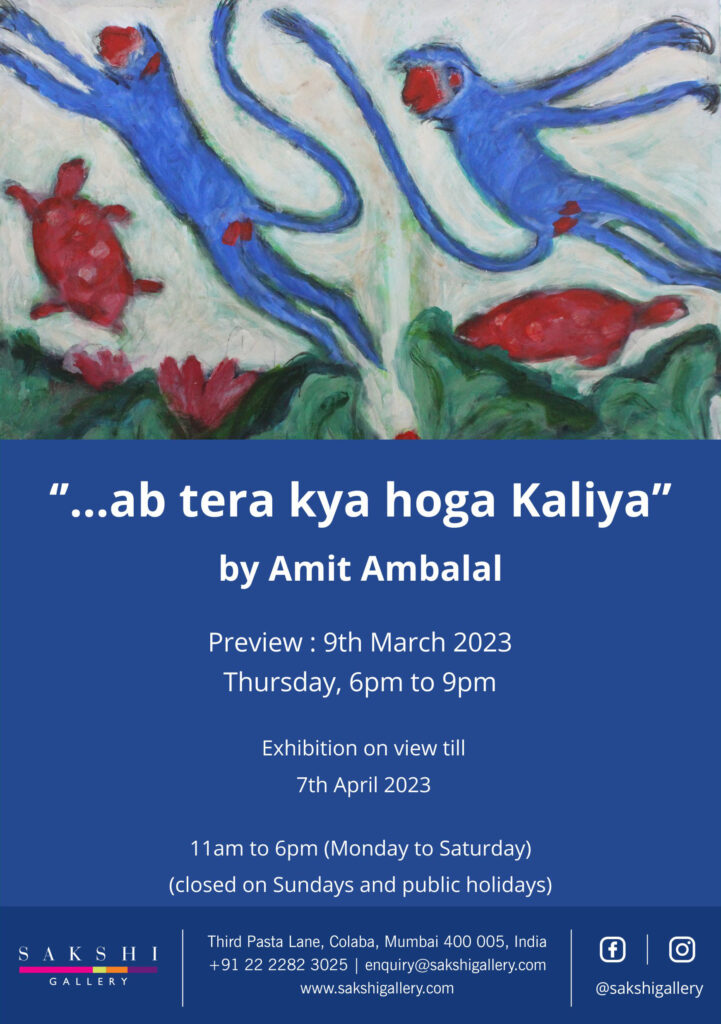This narrative is about Amit Ambalal and his paintings… No, not about “Shrinathji,” “Pichwais” or “Nathdwara…”
They exist together in the landscape of Amit’s being.
He experiences pleasure – “Ananda” – as he paints in his studio. From there, he can see the “Leela” of life and “Vrindavan,” where the child Krishna is playing a game of ball with his cowherd friends. The ball suddenly spins and falls into the river Yamuna. Krishna runs to retrieve it. The river is the lair of the many-headed venomous serpent, Kaliya, and his consorts persuade Krishna not to disturb him. Fearlessly, he jumps into the river, harnesses the serpent and throws the ball towards his friends.
Magically, the ball lands in Amit’s paintings.
Interestingly, this has a magnetic pull, which draws Amit to create a magical pictorial world of his own.
Painted in red, the ball transforms into an orb and the connection between the ball and Kaliya unfolds with the title, ‘…ab tera kya hoga Kaliya,’ where water splashes from the river, as startled langurs jump over the ball and fall into a bed of lotus flowers.
“Just Missed” also focuses on the ball, where langurs run helter-skelter, frightening fish and turtles, so that they hastily swim away in the shallows.
Although, Amit knows they are all waiting for the child Krishna to appear…
With such anecdotes, Amit reveals his thought process, technique, stories, fables, myths and day-to-day happenings, which give form to his paintings.
Amit paints his tigers in different colours. In “Testing Times,” he paints a tiger in ferocious blue, gently licking dew-drops from the heart of a lotus and majestically trampling a lotus-bud even as an impudent turtle bites his tail. But then, tigers also have their moods; a pink-tiger with folded paws, almost cat-like, sits on his hind legs, hypnotized by the bulb-eyes of a giant dragon-fly.
In these paintings, the lotus-crazy tigers breathe deep into their fragrance, gently nibbling at lotus-stems and foraging in their private paradise. Stories and interpretations keep changing. There is always an element of surprise, as a langur is almost hit on the head with the ball and leaps over it. A turtle swims away and the ball falls into the river, causing a fountain of water to rise and fall around them. Quickly, langurs and turtles scuttle helter-skelter as they know what will happen next, that the serpent is coiled in deep slumber on the river-bed.
The animal world knows he should not be disturbed.
Like Amit, they also know, this is no ordinary ball.
It is a moment of magic.
It is the child Krishna’s ball.
The Blue God is unseen, but Amit knows that somewhere nearby, he is playing with his friends. The ball spins; bounces and falls into the lotus leaves and glides deeper into the river Yamuna. This particular story has many connotations, sans the visible forms of Kaliya, Krishna, Vrindavan or Yamuna.
Once, when Amit Ambalal was in Mathura, he stood on the banks of river Yamuna, contemplating about “Kaliya’s” poisonous venom, which had spread in the river. He felt, it was similar to the present-day river, as it was no longer exuberant, but polluted by toxic waste. These are the sources of Amit’s paintings
Similarly, the colours of Nathdwara enter Amit’s paintings with bright pinks, blues, greens and deep yellows, which connect him to his life-long passion for “Pichwais.” His forms stand out on the canvas with vigorous lines, and the pink lotus almost always appears as a metaphor of his pictorial world, which has become part of his artistic sensibilities.
Amit gives another dimension to his work, when his satire and humorous style emerge in his paintings of elephants, which have quite another story to tell. Covered with ceremonial trappings they resemble temple elephants. They appear to be weightless, lithe and energetic, playfully spraying water on a jackass in “Raag Malhar.’ Gleefully with mischievous eyes, these elephants flap their lotus-leaf-like-ears at a Godman who boasts about the miracles he can perform. The elephant appears to be laughing, while swatting a grasshopper; spraying the Godman with water and exposing his arrogance and deceit, as shamefacedly he walks away; in the painting, “Water Wizard.”
In the same tone, Amit makes a light-hearted comment on the human condition in the painting ‘Trunk and Tail’ where a man in a tiger-mask balances himself precariously on an elephant’s trunk. In the same tone, Amit makes a light-hearted comment on the human condition in the painting ‘Trunk and Tail’ where a man in a tiger-mask balances himself precariously on an elephant’s trunk.
The title of the painting ‘Monkeys of the Blue God’, raises a question, “where is the Blue God?”
Where is Krishna as Shrinathji?
Maybe, in Nathdwara, in a Pichwai or in Amit’s heart….
